|
80x5 -
240x3 -
240x4 -
320x1 -
320x2 -
320x3 -
640x1 -
640x2
Set display option above.
Click on
images to enlarge. |
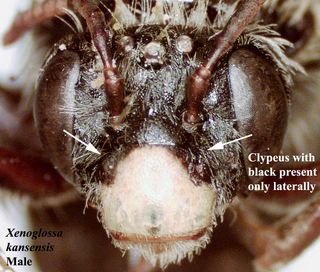
© USDA Bee Biology and Systematics Laboratory, Logan Utah
· 1
Xenoglossa kansensis, male, face text |
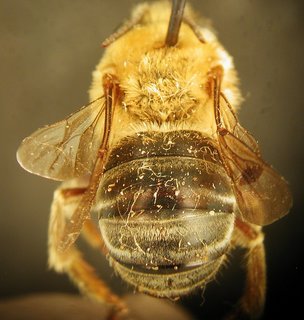
© Mary Paul
· 1
Xenoglossa kansensis, male, top |
|
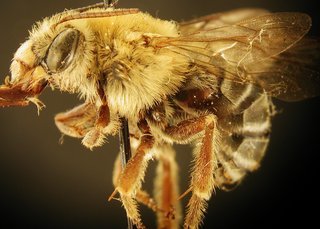
© Mary Paul
· 1
Xenoglossa kansensis, male, side |
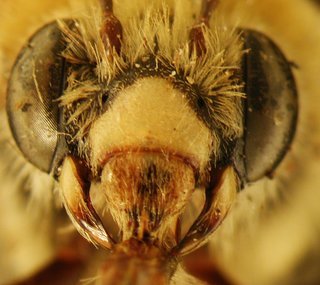
© Mary Paul
· 1
Xenoglossa kansensis, male, face |
|
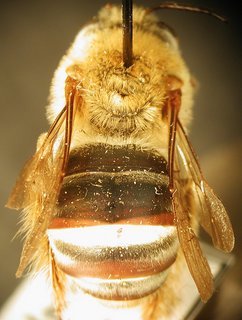
© Mary Paul
· 1
Xenoglossa kansensis, female, top |
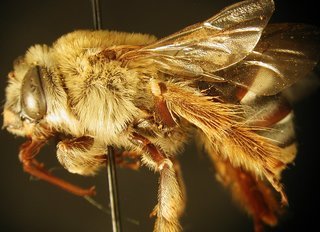
© Mary Paul
· 1
Xenoglossa kansensis, female, side |
|
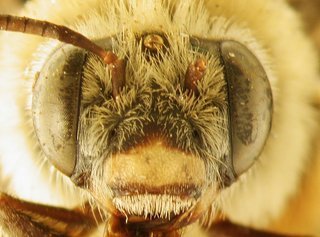
© Mary Paul
· 1
Xenoglossa kansensis, female, face |
|
Overview |
Reprinted with permission from: Mitchell, T.B. 1962 Bees of the Eastern United States. North Carolina Agricultural Experiment Station Technical Bulletin No. 152.
FEMALE—Length 14-16 mm., breadth of abdomen 6 mm.; black, the labrum dull yellowish, mandibles pale yellowish at base, piceous, sometimes with an apical testaceous maculation (fig. 73); apical half of clypeus yellow; legs piceous, mid and hind spurs dull testaceous, tegulae yellowish-hyaline; wings faintly yellowish-brown, veins piceous; cheeks very slightly narrower than eyes; clypeus rather strongly protuberant, its median length half the distance between eyes below; eyes slightly divergent below; mandibles slender and simple apically, with a slight, inner, sub-basal angle; basal segment of flagellum very slightly longer than segments 2 and 3 combined; median length of labrum about two-thirds the basal width, apical margin rather broadly truncate; clypeus closely and rather coarsely punctate, becoming more finely and densely so toward apical margin; labrum somewhat more deeply but finely punctate medially, punctures becoming somewhat coarser but still close laterally; supraclypeal area rather dull, with scattered, rather sparse, shallow punctures, those on lateral surfaces of face below level antenna &low and rather close, becoming minute and close above antennae; surface between eyes and ocelli shining, nearly impunctate; cheeks finely and closely but quite distinctly punctate; scutum, scutellum and pleura quite closely and finely punctate throughout, propodeum posteriorly very xiinutely punctate, lateral faces dull, very finely closely punctate; abdominal terga 1-3 rather dull, punctures quite deep and distinct, rather fine in general, crowded laterally, becoming well separated medially on 1 and 2, uniformly close on 3 and 4; terga 1-4 narrowly impunctate along apical rims; pygidium subtriangular, apex narrowly rounded; pubescence pale ochraceous, quite dense and elongate on head, thorax, legs, and basal abdominal tergum, rather short but very dense on dorsum of thorax, hiding the surface, dense, copious and elongate on each side of propodeum, somewhat paler and thinner over most of and on pleura below and posterior face of propodeum; basal tergum largely bare over apical half; terga 2 and 3 largely bare, each a narrow, basal, greyish tomentose area which is largely covered by the preceding tergum, this narrowly contiguous with a sub- median greyish fascia on 3 that fringes the apical impressed area at base but is widely interrupted medially; tergum 4 with a nearly complete, submedian greyish fascia; tergum 5 greyish tomentose across base, with a dense apical fimbria of more ochraceous pubescence.
MALE—Length 14-15 mm., breadth of abdomen 5-6 mm.; black, the clypeus bright yellow in large part, apical margin narrowly testaceous and dorsal margin invaded only slightly with black, if at all (fig. 73); labrum yellowish, mandibles broadly yellowish at base, more testaceous or orange; legs brownish-ferruginous to piceous, mid and hind spurs rather dull testaceous; tegulae yellowish-hyaline; wings lightly infuscated, veins piceous to black; cheeks subequal to eyes in width; dypeus quite strongly protuberant, its median length somewhat greater than half the distance between eyes below; eyes very slightly divergent below; mandibles slender and simple apically, the sub-basal inner angle weakly developed; basal segment of flagellum considerably shorter than segments 2 and 3 combined; punctures of clypeus rather coarse and close, on labrum somewhat finer; supraclypeal rather dull, punctures obscure, lateral below level of antennae dull, punctures shallow and vague but rather close, becoming somewhat finer and closer above antennae, surface shining between eyes and lateral ocelli; cheeks finely and closely punctate beneath rather dense but short pubescenc; scutum, scutellum, pleura and propodeum quite dull, punctures rather fine and close, somewhat more minute on posterior face of propodeum; terga rather dull, punctures well separated medially on 1 and 2, becoming densely crowded at lateral margins, apical impressed areas closely and regularly punctate except for the narrow rims; terga 3-6 finely and closely punctate throughout except for the narrow apical rims, more minutely and densely punctate on the more apical terga; tergum 6 with a robust, sharply acute and slightly curved, posterior spine on each extreme side; pubescence largely pale ochraceous on head and thorax, quite short, dense and somewhat more fulvous on dorsum of thorax, more whitish face and cheeks below, rather copious and elongate on basal half of basal abdominal tergum; terga 2 and 3 without distinct basal fasciae; apical impressed areas of 3-6 to some degree fringed with greyish tomentum, widely interrupted on 3, discs otherwise largely bare; median length of pygidial plate about equal basal width, margins subcarinate, converging apically, the apex abruptly flared beneath and broadly rounded; sterna 7 and 8 and genital armature as shown (fig. 74).
DISTRIBUTION—Kansas to North Carolina and Georgia, May to July.
FLOWER RECORDS—Cucurbita and Ipomoea.
|
|
|
Names | |
|
|
| Supported by | |
Updated: 2024-07-27 01:29:30 gmt
|